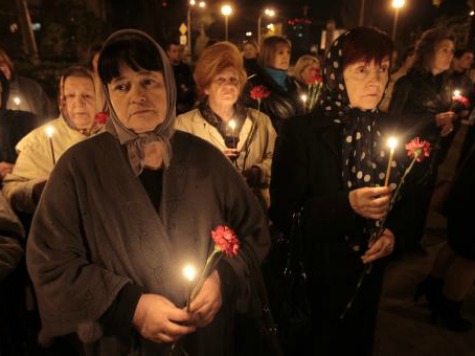On April 26, 1986, a routine test at the Soviet Union’s Chernobyl nuclear power plant went awry, causing the single greatest ecological disaster in history. As Ukraine prepares to observe this grim anniversary, tensions between the state and separatists favoring Russia threaten to halt ongoing cleanup operations at the still-toxic locale.
As Fox Business reports, a long-term plan to replace the thinning covering above the exploded nuclear reactor at the Chernobyl plant may see delays of up to two years because of hostilities between the Russian and new Ukrainian governments, as payments to the contractors responsible for the reconstruction may stop. The cover is necessary, as the initial explosion released only 3% of the nuclear materials in the plant, one expert explains to Fox; any stimulus can trigger an explosion that would release the other 97% into the sky.
The covering above the exploded nuclear reaction #4, colloquially referred to as the “sarcophagus,” was built only with the intention of lasting two or three decades. To that end, plans were made to replace the sarcophagus in 2015 with a new covering called the New Safe Confinement, something of a dome construction that would enclose any radioactive materials stirred into the air by wind or weather. The confinement would cover the decaying sarcophagus itself and “could house the Statue of Liberty.”
The timely construction of the New Safe Confinement, however, is now in jeopardy. Ukrainian government officials are concerned that, due to political tensions, the Russian government will back out of its promise to pay for the confinement, which would leave Ukraine with barely enough money to finish the construction two years late. Vincent Novak, the director of nuclear safety for the European Bank for Reconstruction and Development, told Fox Business that the project is “clearly” behind schedule and underfunded: “Our current contract for completion in October 2015 can’t be maintained. The schedule is currently being revised, but is likely to be a year or two late,” he said.
A year or two of delay could expose millions of Ukrainians and neighboring Belarusians to radioactive materials, which cause birth defects and cancer, and are suspected to cause numerous other diseases that scientists have yet to definitively link to radioactivity.
While much of the radioactive materials currently in the Chernobyl exclusion zone have decayed sufficiently to allow only modest human infection, any long-term exposure to the radioactive elements in the abandoned town of Pripyat and the forest surrounding the nuclear power plant are extremely dangerous. Millions of children were affected by the tragedy, and millions more were impacted both physically and psychologically in ways yet to be fully understood.
For those interested in a deep, personal look at the ravages of Chernobyl on the individuals, particularly children, who were forced out of the area by the disaster, the 2007 short film White Horse is one resource. It follows the voyage of a man forced to evacuate the town of Pripyat, home to the Chernobyl nuclear plant workers, when he was a child. The man returns to Pripyat twenty years later–to his bedroom, his playgrounds, and the school he left behind.

COMMENTS
Please let us know if you're having issues with commenting.